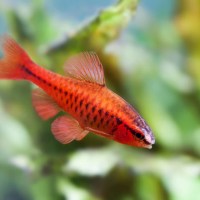Description
Video of the actual fish
Angelfish have a long history as aquarium residents. Initially hard to breed, their process of domestication started decades ago and continues to this day. During this process, it’s likely that a few currently undescribed species were crossed, giving an aquarium strain that differs from their wild relatives and occurs in a wide range of colour, scale and fin types. Black angels seem to require more protein that other forms and should be fed a richer diet when young, to ensure healthy growth.
Most people who’ve owned a community tank have kept angels and they’re often added to unsuitable aquaria where they eat small tetra tank mates and bully their companions. Although they’re cichlids, angels are sociable and naturally live in groups. Pairs leave the group to spawn and rear their young in temporary territories held during the breeding season. To echo this way of life, they’re best kept as a group in a tank large enough for pairs to form and form discreet territories. Kept in this way, they’ll be far too busy to bully any other species unless they’re chasing them from their chosen spawning site. Eating small fish is harder to prevent and this is why they should never be housed alongside small tetras such as Neons. Tankmates too large to swallow whole are generally ignored but take care to avoid adding tank mates likely to nip the angel’s fins.
These are hard fish to sex as youngsters but as males grow faster than females, buying a mix of sizes (within a group of fishes the same age) should guarantee pairs. To avoid young fish harassing one another, go for a minimum of four individuals of whatever colours appeal.
Feeding
Will accept all manner of aquarium fare: flake, slowly-sinking pellet foods, frozen foods such as mosquito larvae, brineshrimp, Mysis, daphnia etc.





Reviews
There are no reviews yet.